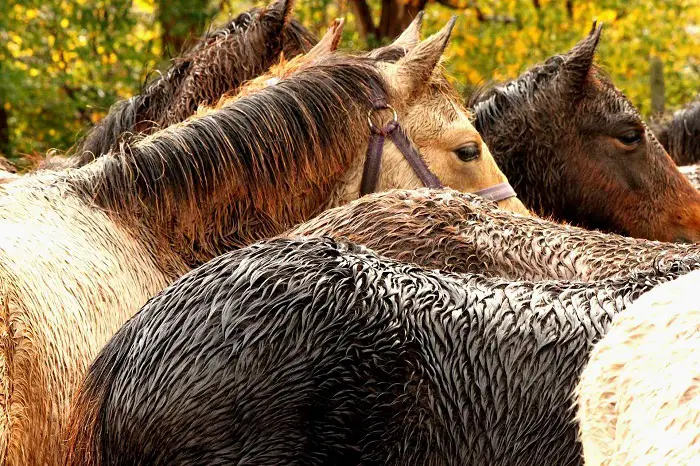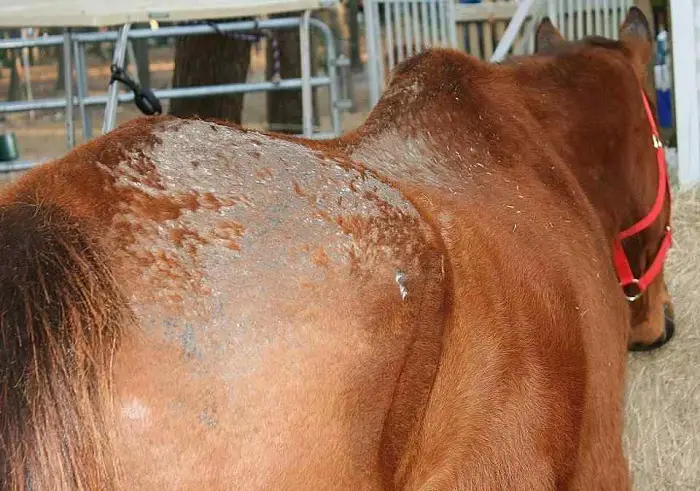Rain rot, also known as dermatophytosis or rain scald, is a common skin condition that affects horses. Rain rot in horses is caused by a bacterium called Dermatophilus congolensis. Rain rot typically occurs in humid and wet conditions, such as during prolonged periods of rain or when horses are exposed to damp environments.
The bacterium Dermatophilus congolensis lives on the skin of horses and becomes activated when the skin remains wet for an extended period. The moisture causes the bacterium to multiply and invade the outer layers of the skin, leading to the characteristic symptoms of rain rot.
Causes of Rain Rot in Horses
Rain rot in horses is primarily caused by a bacterium called Dermatophilus congolensis. However, several factors contribute to the development and spread of rain rot. These factors include:
- Moisture: Prolonged exposure to wet and humid conditions significantly contributes to the development of rain rot. Rain, high humidity, and excessive sweating can create an environment helpful to the growth of bacteria.
- Poor Hygiene: Horses kept in dirty or unsanitary conditions are more susceptible to rain rot. Accumulated dirt, mud, or manure on the horse’s coat can create a favorable environment for bacterial growth.
- Compromised Skin Barrier: Horses with compromised skin barriers are more prone to rain rot. Injuries, cuts, abrasions, or skin irritations weaken the skin’s protective layer, making it easier for the bacterium to invade and cause an infection.
- Overcrowding: Horses kept in crowded or confined spaces, such as overcrowded pastures or stables, are more likely to develop rain rot. Close contact between horses increases the likelihood of the bacterium spreading from one horse to another.
- Weakened Immune System: Horses with weakened immune systems are more susceptible to infections, including rain rot. Factors such as poor nutrition, stress, underlying illnesses, or certain medications can effectively compromise the immune system’s ability to fight off bacterial infections.
Clinical Signs of Rain Scald in Horses
The clinical signs of rain scald, also known as rain rot or dermatophytosis, in horses, typically include:
- Lesions: The most common sign of rain scald is the development of raised, scabby, crusty, or scaly skin lesions. These lesions are often circular or irregularly shaped and can vary in size. They are commonly found on the horse’s back, neck, rump, and other areas exposed to rain or sweat.
- Hair Loss: Affected areas may experience hair loss, exposing the skin. This can give the appearance of bald patches or thinning hair in the affected regions.
- Scabs: The lesions often develop scabs, which can appear dark or crusty. These scabs may be firmly adhered to the skin and can vary in size.
- Inflammation and Redness: The skin around the lesions may appear inflamed, reddened, or swollen. The affected areas can be warm to the touch and sensitive or painful when touched.
- Itching and Discomfort: Horses with rain scald may experience itchiness or discomfort in the affected areas. They may rub against objects or bite the affected skin to relieve the itch or discomfort.
- Secondary Infections: In severe cases or when left untreated, rain scald lesions can become infected with other bacteria or fungi, leading to additional symptoms such as increased inflammation, discharge, or a foul odor.
Diagnosis of Rain Scald in Horses
The diagnosis of rain rot, also known as rain scald or dermatophytosis, in horses typically involves a combination of physical examination, clinical signs, and sometimes laboratory testing. Here are the standard methods used for diagnosing rain rot:
- Physical Examination: The veterinarian will thoroughly examine the horse, paying particular attention to the skin. They will look for the characteristic lesions, scabs, hair loss, and other signs of rain rot. The distribution and appearance of the skin lesions can provide important clues for diagnosis.
- History and Clinical Signs: The vet will inquire about the horse’s history, including recent exposure to wet or humid conditions, poor hygiene, or other factors that could contribute to rain rot. The presentation of clinical signs, such as circular or irregular lesions with scabs and hair loss in areas prone to moisture, can further support the diagnosis.
- Microscopic Examination: In some cases, the veterinarian may collect a sample from the affected area for microscopic examination. This sample can be obtained by gently scraping the surface of a lesion or by taking a swab. The collected material is then evaluated under a microscope to identify the presence of the bacterium Dermatophilus congolensis. The bacteria typically appear as filamentous branching structures called “spaghetti and meatballs” due to their characteristic appearance.
Differential Diagnosis of Dermatophytosis in Horses
A veterinarian must consider other potential differential diagnoses when evaluating a horse with skin lesions resembling rain scald (rain rot or dermatophytosis). Several skin conditions can present with similar clinical signs, and a thorough examination is necessary to reach an accurate diagnosis. Some common differential diagnoses for rain scald in horses include:
- Dermatophytosis (Ringworm): Ringworm in horses is a fungal infection that can cause circular or irregularly shaped lesions with hair loss and scaling. Unlike rain scald, ringworm lesions often have a more defined border, and the affected hair may break off easily, leaving a stubble-like appearance.
- Bacterial Folliculitis/Furunculosis: Bacterial infections of the hair follicles can cause similar lesions to rain scald. These infections are often caused by different bacteria, such as Staphylococcus spp., and can result in pustules, abscesses, or crusting.
- Allergic Dermatitis: Allergic reactions to environmental allergens, such as insects, plants, or certain bedding materials, can lead to skin lesions resembling rain scald. These lesions may be accompanied by itching, redness, and inflammation.
- Mange (Chorioptic or Sarcoptic): Mange in horses is caused by mites and can result in severe itching, hair loss, crusting, and skin thickening. While rain scald typically occurs on the back, neck, and rump, mange lesions can appear in various areas, including the legs and face.
- Contact Dermatitis: Skin irritation or allergic reactions from contact with certain substances, such as harsh chemicals, topical medications, or plants, can cause similar skin lesions. The distribution of the lesions may provide clues to the causative agent.
- Photosensitization: Photosensitization occurs when the horse’s skin becomes hypersensitive to sunlight, leading to sunburn-like lesions, especially on areas exposed to the sun. Photosensitization can be caused by ingesting certain plants or medications, and it can resemble rain-scald lesions.
- Ectoparasites: Infestations by external parasites, such as lice or ticks, can cause skin irritation, itching, and hair loss. These lesions may differ from rain scald in appearance and distribution.
Treatment of Dermatophytosis in Horses
Treating rain scald in horses typically involves a combination of management practices, topical therapies, and, in some cases, systemic medications. Here are some common approaches used to treat rain scald:
Management Practices:
- Remove the horse from wet or humid environments to prevent further exposure to moisture.
- Provide a clean and dry environment for the horse, ensuring proper ventilation.
- Avoid using blankets or rugs that can trap moisture against the skin.
- Separate affected horses from others to prevent the spread of the condition.
Grooming and Cleaning:
- Gently remove scabs and crusts from the lesions using warm water, mild antiseptic solutions, or medicated shampoos recommended by a veterinarian.
- Thoroughly clean grooming tools, such as brushes, sponges, and curry combs, to prevent cross-contamination.
- Regularly groom the horse to remove dirt and debris contributing to the infection.
Topical Treatments:
- Apply topical antimicrobial or antiseptic solutions a veterinarian recommends directly to the affected areas. This may include chlorhexidine, povidone-iodine, or other medicated shampoos or sprays.
- Follow the instructions provided by the veterinarian regarding the application frequency and duration of treatment.
Systemic Medications:
- The veterinarian may prescribe systemic antibiotics or antifungal medications in severe cases or when the infection is widespread. These medications are aimed at controlling bacterial or fungal infections.
- Administer the prescribed medications as directed by the veterinarian and complete the entire course of treatment.
Immune System Support:
- Provide a balanced and nutritious diet to support the horse’s immune system and overall health.
- Ensure the horse has access to clean water and proper turnout or exercise.
Prevention and Control of Rain Scald in Horses
Preventing and controlling rain rot in horses involves implementing good management practices and taking proactive measures to minimize the risk of infection. Here are some preventive measures that can help prevent rain rot:
Provide a Clean and Dry Environment:
- Ensure horses have access to clean, dry, and well-drained shelters or stables.
- Regularly remove manure and wet bedding from stalls or paddocks to maintain cleanliness.
- Avoid overcrowding and provide sufficient space for each horse.
Grooming and Hygiene:
- Regularly groom horses to remove dirt, mud, and sweat from their coats. This helps to prevent the buildup of moisture and reduces the risk of bacterial growth.
- Clean grooming tools, such as brushes and combs, regularly to prevent cross-contamination.
Proper Blanketing:
- Use breathable blankets or rugs that allow moisture to evaporate rather than trapping it against the horse’s skin.
- Remove and dry blankets regularly to prevent moisture buildup.
Drying Off:
- After exercise or exposure to rain, ensure horses are properly dried off using towels or coolers to remove excess moisture from the coat.
Pasture Management:
- Rotate pastures regularly to prevent overgrazing and reduce exposure to wet or muddy conditions.
- Provide shelter or access to trees for horses to seek protection from rain.
Avoid Overexposure to Rain:
- Bring horses indoors during heavy rain or storms to prevent prolonged exposure to wet conditions.
Balanced Nutrition:
- A balanced and nutritious diet supports a healthy immune system and maintains optimal skin health.
Monitor and Early Intervention:
- Regularly inspect horses for any signs of skin lesions, especially in areas prone to rain rot. Early detection allows for prompt intervention and reduces the severity of the infection.
Quarantine and Isolation:
- Isolate horses with active rain rot lesions from others to prevent the spread of the infection.
Final Talk on Rain Rot in Horses
Rain rot, also known as rain scald or dermatophytosis, is a common skin condition that affects horses. Rain scald is caused by the bacterium Dermatophilus congolensis and is often triggered by prolonged exposure to wet and humid conditions. While rain rot is not life-threatening, it can cause discomfort and affect the horse’s overall well-being if left untreated.
The key to managing rain rot effectively lies in prevention, early detection, and appropriate treatment. Good management practices, such as providing a clean and dry environment, regular grooming, and proper nutrition, can help reduce the risk of rain rot. It is important to keep horses in dry and well-ventilated areas, avoid overcrowding, and maintain proper hygiene to minimize the chances of infection.
If rain rot does occur, prompt intervention is crucial. A veterinarian should be consulted to confirm the diagnosis and provide a tailored treatment plan. Treatment typically involves cleaning and removing scabs, using topical antiseptic solutions or medicated shampoos, and, in severe cases, administering systemic medications. Regular grooming, cleaning of grooming tools, and quarantine of affected horses are essential to preventing the spread of the infection.
By following these preventive measures and promptly addressing rain rot with appropriate treatment, horse owners can help minimize the impact of this condition and promote the overall health and well-being of their equine companions.

